|
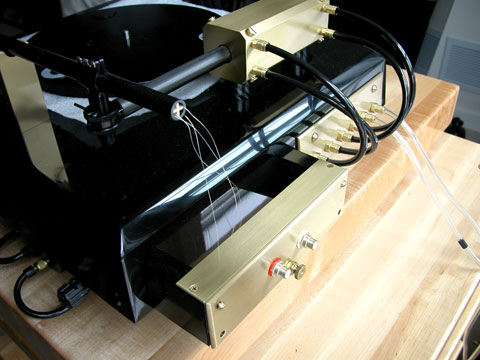
A second view of the right rear of the
Proscenium, with all air tubing installed. The black tubes are distribution
lines on the turntable itself; the two clear tubes are the main supply lines
from the air pump itself.
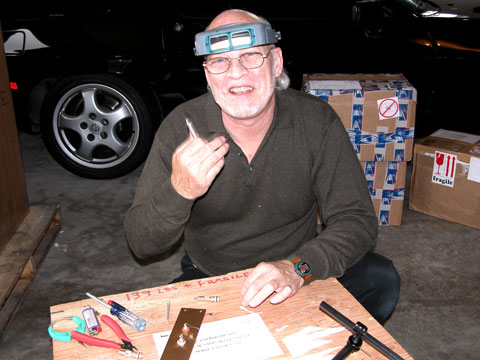
Lloyd prepares to install the silver MC cartridge
leads directly to the RCA connectors for the Walker Audio Reference Phono Amp,
Second Edition. The amount of "shortest path, direct point-to-point" wiring in
the Walker Audio gear was unprecedented in my experience.
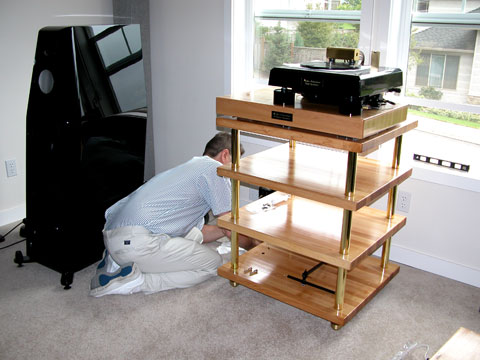
Fred Law works on connecting the main air supply
tubing to the air pump.
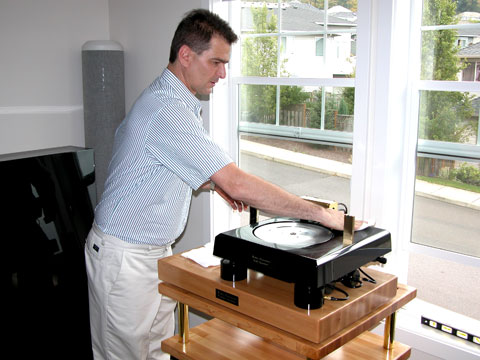
Fred cleaning and polishing the Proscenium Gold
Signature chassis before adding the platter, tonearm, and motor drive. The
finish is a beautiful glossy piano black; no one who sees it forgets how
attractive the Proscenium is.
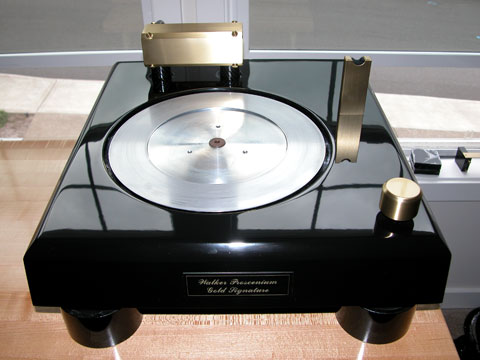
After polishing, the Proscenium awaits the next
step in the assembly. This portion alone weighs about 170 pounds. Mass, mass,
mass….
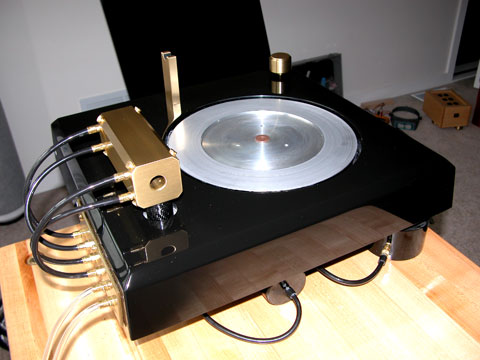
Here's another view of the Proscenium, showing
the main supply and distribution tubing, the air chamber for the linear tracking
tonearm, and the sub-chassis air chambers. You can see how the suspension pod to
the right is fed from the sub-chassis system via its connector. This is a very
sophisticated complex, yet its footprint remains rather small, allowing for
tubing, at 19" wide x 22" deep x 10" high.
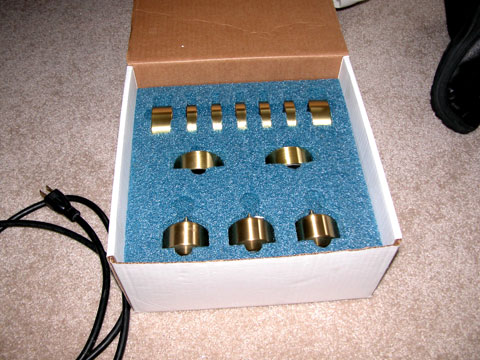
Another aspect of the installation process was
the deployment of Walker Audio's solid brass Valid Points, and Valid Points
brass and lead tuning pucks. These turned out to be smashing good…the best that
I've ever used in my listening room.
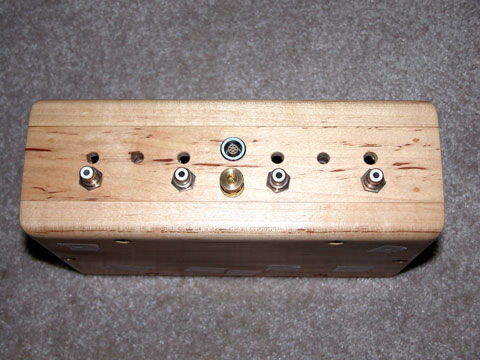
Looking downwards at the Walker Audio Reference
Phono Amp, Second Edition. The round female connector in the upper middle is the
dedicated port for the Walker Reference Phono Amp Power Supply; just below that
is a brass grounding post. The two inner RCA female jacks, just to either side
of the grounding post, are the inputs from the MC leads. The outermost RCAs are
the outputs to the line preamp. The construction is solid maple, with remarkable
point-to-point wiring using pure naked silver inside. This is a solid-state
device; all internal solid-state components are stripped of extraneous coatings,
and specially shielded inside the chassis. The Walker Audio approach to phono
amplification is unique …the results were spectacular.
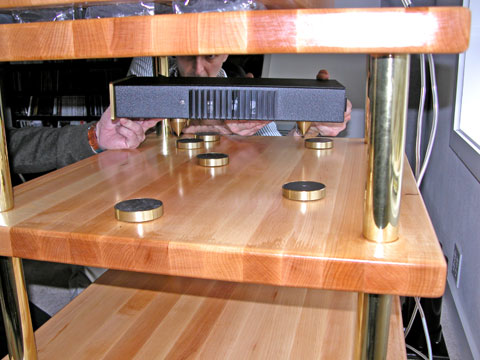
Fred Law takes the first pass at putting the
Walker Audio Ultimate Motor Controller in place; note the Valid Points and
Tuning Discs underneath, and the second set in the foreground for the phono
amp's power supply. The Valid Points Resonance Control System provided
comprehensive handling of vibration and resonances in the Proscenium system—and everywhere else we used it. Audio tweakers, take note: this is top o' the
heap, as far as I'm concerned.
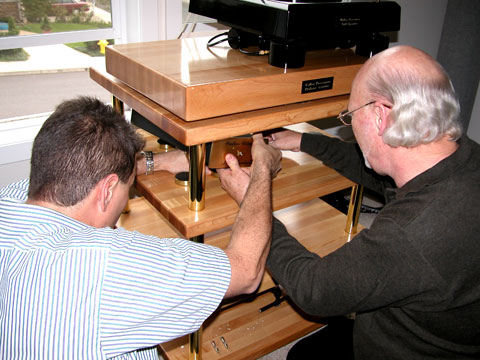
Fred and Lloyd worked hard to get all the
components arranged just right, and their placement on the Valid Points Tuning
Discs precisely so. Nothing was done without a great deal of care and
consideration.
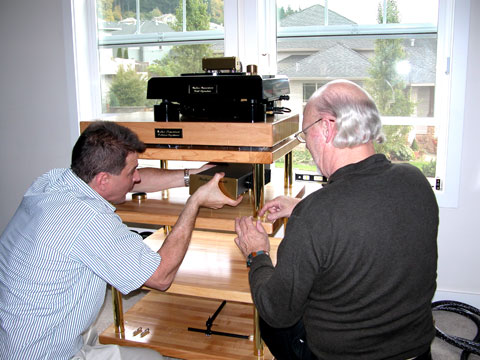
After that first pass, Fred and Lloyd decided
that the Ultimate Motor Controller belonged on the right, and not on the left.
They shifted the arrangement accordingly.
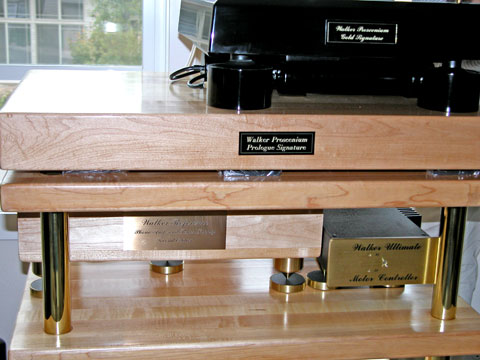
Once the Walker Ultimate Motor Controller was
shifted to the right, the Walker Reference Phono Amp and Power Supply, Second
Edition, went to the left on its own set of Valid Points and Tuning Discs.
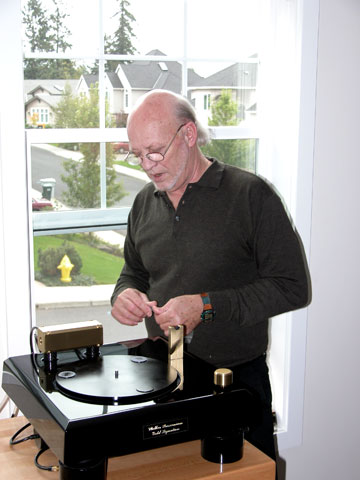
That being done, Lloyd set to work on installing
the rest of the Proscenium system. Next up: the installation of the damping
trough and the tonearm in the air chamber.
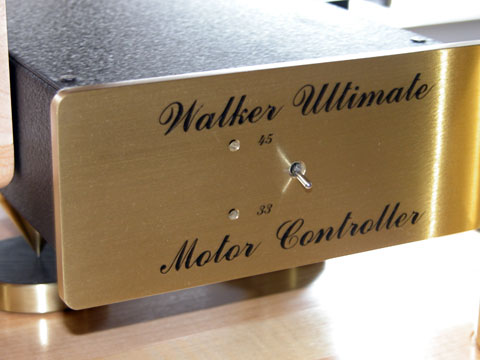
Another view of the Walker Ultimate Motor
Controller, now in its place on its Valid Points and Tuning Discs.
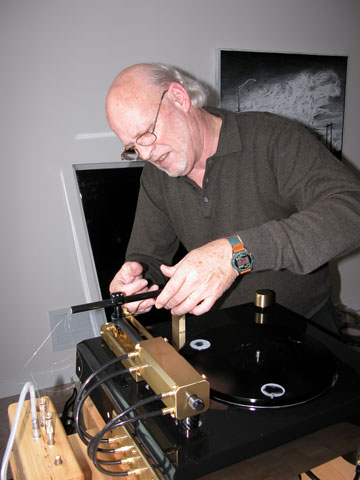
Before placing the platter, Lloyd installed the
linear tracking tonearm system. I haven't seen anything like this; the tonearm
is pure carbon fiber, with internal cross-bracing that reinforces the arm, and
provides four equal longitudinal chambers for the very fine silver phono wire
that Lloyd uses. The tonearm itself is attached to a round guide arm, which is
cradled in turn by the coated, solid brass air chamber in the foreground. The
damping trough for the tonearm and guide arm is immediately underneath the guide
arm, to the far side of the air chamber.
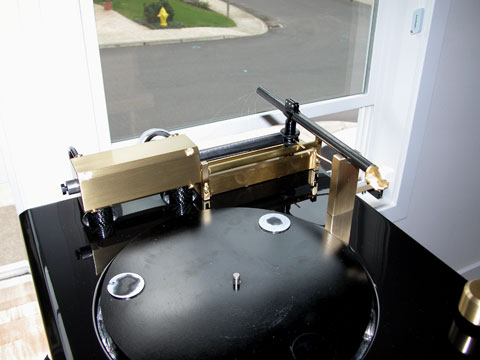
You can see the relationship between the tonearm,
the guide arm, the damping trough, and the air chamber more clearly in this
image. The tonearm is resting on its brass holder. In the foreground to the
right corner is the coated brass leveling control for the turntable.
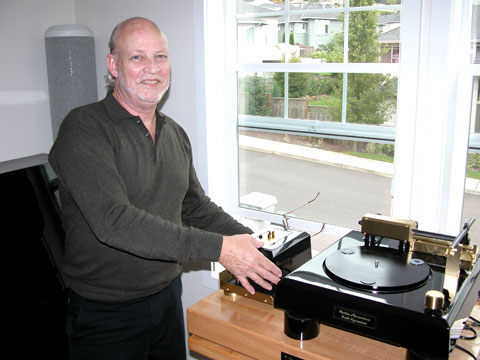
The installation of the tonearm and damping
trough completed, Lloyd Walker then placed the Walker Motor Drive unit, in
preparation for the mounting of the Walker Audio Reference Phono Amp and the
platter.
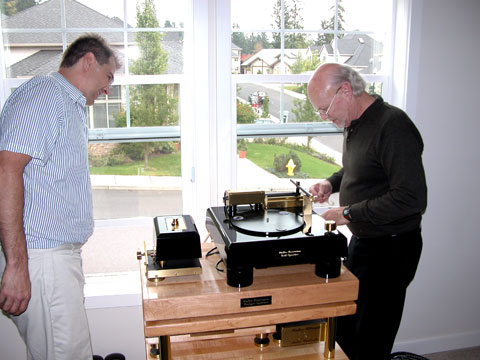
Here Fred and Lloyd are putting the phono amp
into place and checking the pure silver phono leads, each coated with a very
thin (.001" clear Teflon) insulation. Lloyd and Fred are no friends to the
dubious dielectrics of insulation, and avoid or minimize it wherever possible
(which seems to be just about everywhere). This is true no-compromise design of
a kind that is quite rare, even in fine audio.
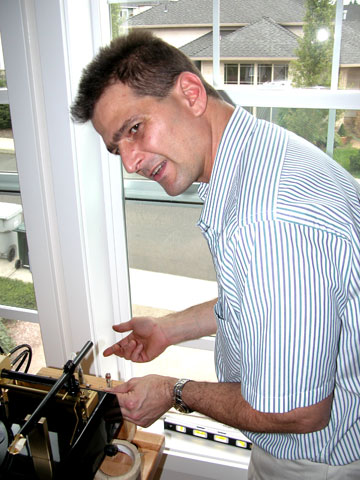
Fred Law adjusts the cabling from the tonearm to
the Walker Audio Reference Phono Amp; each lead had to be carefully adjusted in
space to prevent it from touching any of the other leads. Given the very short
distance involved between the connectors of the Magic Diamond MC and the phono
amp inputs (an actual length of approximately 16"-18"), this was done in just a
few moments. You can see how close the tonearm is to the phono amp in the image
above; the small maple unit just below the back of the tonearm is the Walker
Audio Reference Phono Amp.
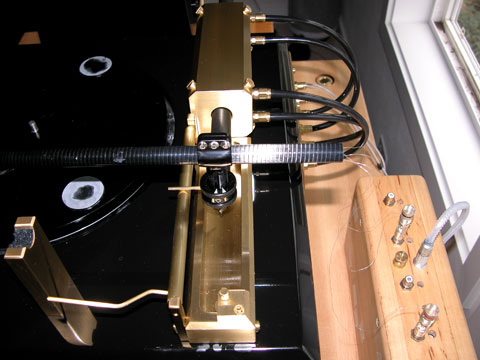
Here you can see more easily the back end of the
Proscenium tonearm, the relative closeness of the tonearm and the phono amp, the
damping point at the base of the tonearm/guidearm coupling, the damping trough
(no synthetic oil yet), and the silver leads to the Walker Reference Phono Amp.
You also see the dedicated power supply connector in place. In the foreground
left, shining brightly, is the cueing arm. The phono amp is secured to the
Proscenium Rack with Blue Tack, which allows it to be placed very conveniently;
just recently, Lloyd has developed a more permanent mounting system, with
brackets. I should point out that the phono amp is not sitting on the
Prologue Stand that the Proscenium occupies, but is instead on the underlying
Prologue Rack. The phono amp and the turntable are therefore decoupled by the
Sorbothane supports under the Prologue Stand…very intelligent design work,
indeed.
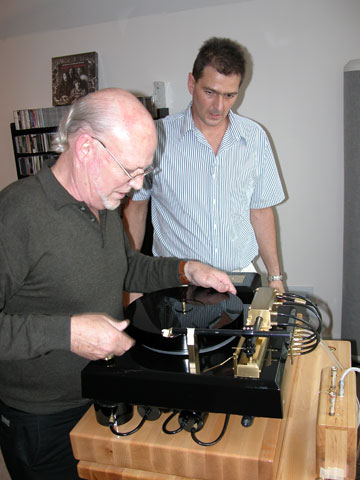
Another "at last!" moment: Lloyd and Fred
install the platter of the Proscenium. Like the chassis, the Proscenium platter
is solid lead, encased in a special coating to prevent contact with the lead.
Speaking of massive: the platter is a phenomenal 75 pounds, all by itself.
Solid again, Jackson!
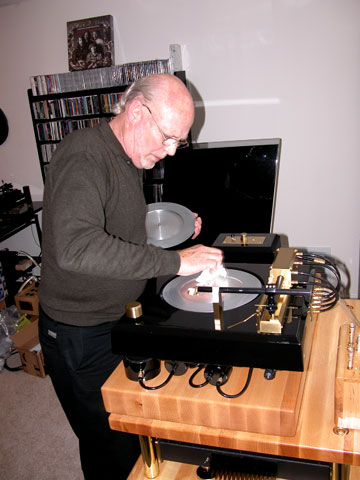
Lloyd pulls the platter for a moment, to re-clean
the underlying plinth.
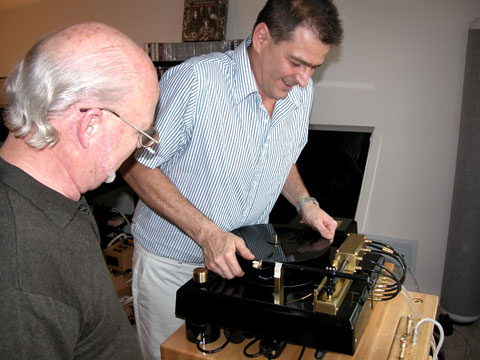
Fred replaces the platter after cleaning, while
Lloyd cheers him on …that thing is heavy!
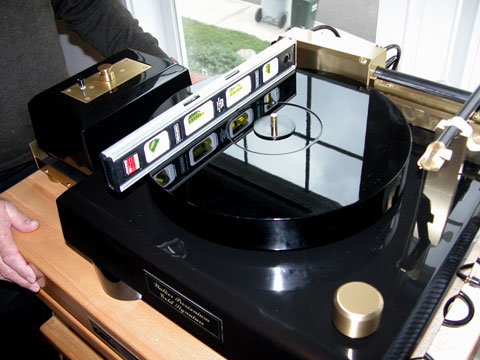
Once the platter was in place, Lloyd and Fred set
about leveling the turntable and platter. The coated brass level adjustment knob
is at the front right of the turntable.
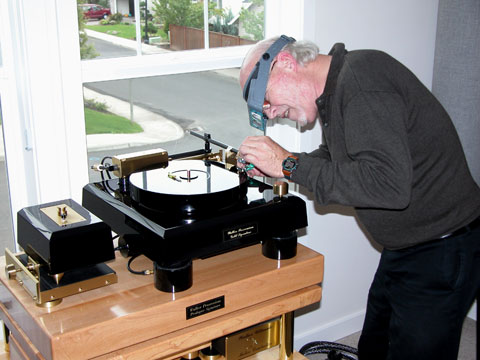
After the Proscenium was leveled, Lloyd prepared
to mount the MC cartridge. In this case, it was the exceptional mid-output
Swiss-made Magic Diamond, produced by Micromagic, which Lloyd recommended as the
preferred device. Art Manzano of Axiss USA was able to provide this for PFO,
so it was at hand. I had spent several days running it out on the departing SOTA
Millennia turntable just before Lloyd and Fred arrived, so it was ready to go.
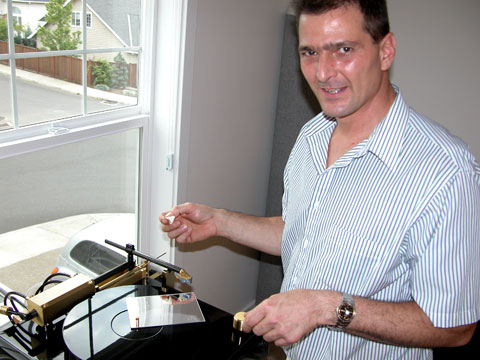
After Lloyd got the Magic Diamond MC mounted on
the Proscenium's tonearm, Fred set about the task of adjusting it for proper
operation.
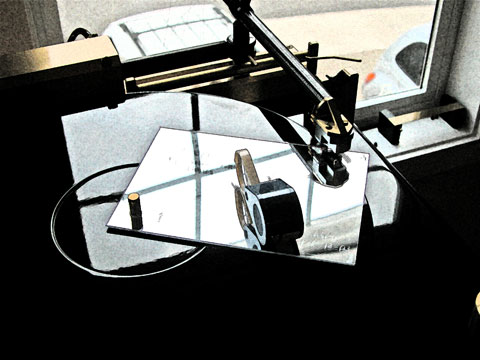
Stylus adjustment, in fresco—couldn't resist
this, since the process has its highly aesthetic side. There's quite a skill set
to this, but not one that's unattainable.
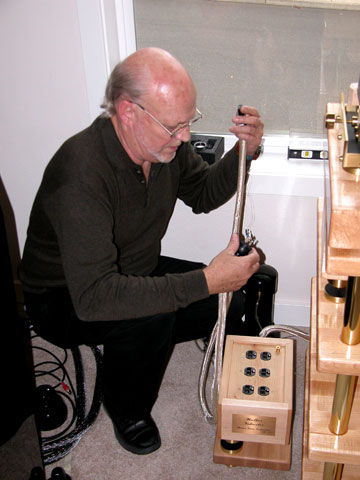
While Fred dialed in the Magic Diamond, Lloyd
worked on deploying the Walker Audio Velocitors, and the Omega Mikro Active
power cords. The results were breath-taking …see my review commentary below.
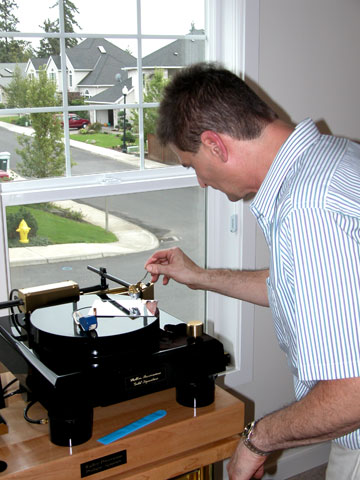
Fred continuing the quest for stylus perfection…
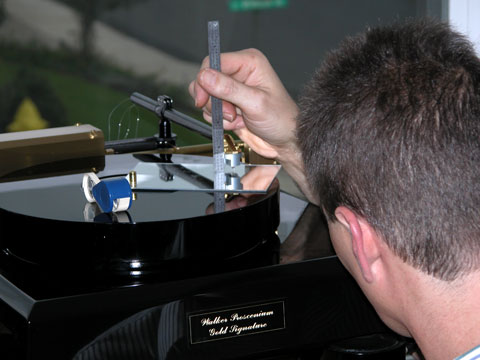
…measuring every parameter carefully…
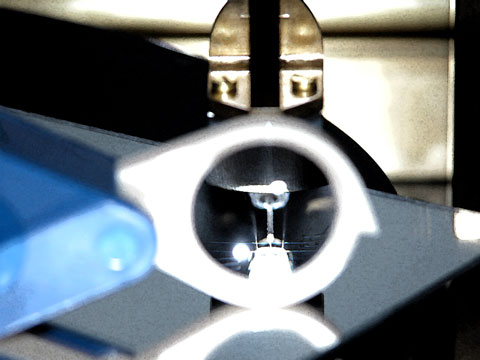
…and keeping a weather eye on the stylus …another
irresistible fresco. Fred was relentless in getting this right.
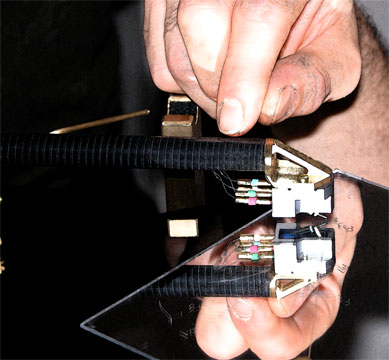
A fresco of the Magic Diamond under Fred's
careful hand.
Page 4
|

































